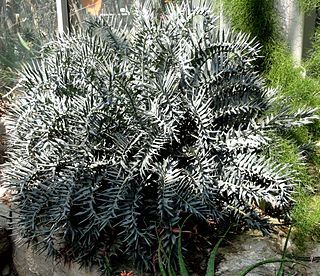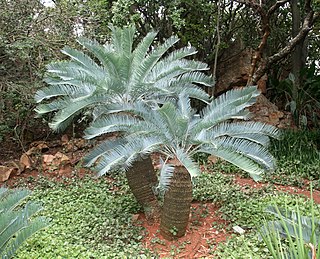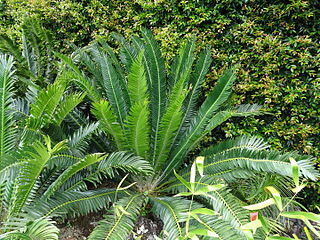
Encephalartos horridus, the Eastern Cape blue cycad, is a small, low-growing cycad up to 0.9 m (3.0 ft) high and 0.9 m (3.0 ft) wide. It is a native of Eastern Cape Province, South Africa, and found in arid shrublands, most commonly on ridges and slopes with shallow soils. The species is particularly known for its distinctly blue-gray leaves, although the degree of coloration can vary significantly. The species name horridus is Latin for 'bristly', after the plant's stiff, spiny leaflets.

Encephalartos lebomboensis is a species of cycad in the family Zamiaceae. Native to the Lebombo Mountains of South Africa, the species was first described in 1949 by the South African botanist Inez Verdoorn. It is commonly known as the Lebombo cycad, although the name is also used for Encephalartos senticosus which also occurs in the same locality.

Encephalartos senticosus is a species of cycad in the family Zamiaceae native to the Lebombo Mountains of Mozambique, Eswatini (Swaziland), and the KwaZulu-Natal province of South Africa. Prior to its description in 1996, Encephalartos senticosus had been confused with the closely related and sympatric Encephalartos lebomboensis. Both species are commonly known as the Lebombo cycad.

Encephalartos whitelockii is a species of cycad that is native to Uganda.

Encephalartos turneri is a species of cycad that is native to Mozambique. The Encephalartos turneri was discovered by Ian Sutherland Turner in Nampula, Mozambique.

Encephalartos trispinosus is a species of cycad that is native to the Eastern Cape Province of South Africa.

Encephalartos gratus is a species of cycad that is native to Malawi and Mozambique.

Encephalartos friderici-guilielmi is a species of cycad that is native to Eastern Cape province and KwaZulu-Natal province of South Africa at elevations of 700 up to 1400 meters.

Encephalartos eugene-maraisii is a species of cycad in the family Zamiaceae. It is endemic to South Africa, where it is limited to Limpopo. It is known as the Waterberg cycad.

Encephalartos concinnus is a species of cycad in the family Zamiaceae. It is endemic to Zimbabwe. It is known as the Runde cycad.

Encephalartos middelburgensis is a species of cycad that is native to Gauteng and Mpumalanga provinces of South Africa at elevations of 1,100–1,400 m (3,600–4,600 ft).

Encephalartos laevifolius is a species of cycad that is found in the KwaZulu-Natal, Mpumalanga and Limpopo provinces of South Africa, and at Piggs Peak in Eswatini. The species is facing extinction in the wild, but is widely cultivated. As of 2012, the Encephalartos laevifolius has been listed as critically endangered by the IUCN.

Encephalartos hildebrandtii is a species of cycad in the Zamiaceae family. It is native to Kenya and Tanzania at elevations from sea level to 600 metres (2,000 ft). The species is named for the German explorer Johann Maria Hildebrandt.

The Chimanimani cycad is a species of cycad that is endemic to the Chimanimani Mountains of eastern Zimbabwe. It is a threatened species which has been locally extirpated by cycad collectors.
Encephalartos schaijesii is a species of cycad endemic to the Democratic Republic of the Congo. It is only found near Kolwezi in Shaba Province, Democratic Republic of the Congo. It occurs in Miombo woodlands.
Encephalartos macrostrobilus is a species of cycad in Africa. It is found only in Moyo District, northwestern Uganda, which is populated predominantly by the ethnic Madi.
Encephalartos mackenziei is a species of cycad in South Sudan. It is found in the Didinga Hills of Namorunyang State.

Encephalartos cerinus or Waxen Cycad is a species of cycad in Africa.
Encephalartos dyerianus, known colloquially as the Lillie cycad, is a species of cycad that is native to hillsides in the lowveld of eastern Limpopo, South Africa.

Encephalartos tegulaneus, the Kenyan giant cycad, is a species of cycad endemic to Kenya. It occurs in Eastern Province near Embu, Kenya, and on the Matthews Range in Rift Valley Province.

















